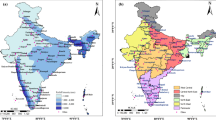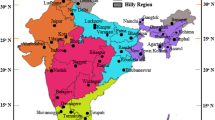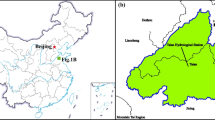Abstract
Heavy rainfall events prediction at the local scale imposes a big challenge for meteorological agencies over the complex terrain areas in India such as Assam, Uttarakhand, and Himachal Pradesh and causes flash floods with severe consequences throughout the area causing a huge socio-economical loss over these regions. Assam is currently experiencing severe flooding in June 2023. Due to the limits of deterministic numerical weather models in accurately forecasting these events, this work investigates the incorporation of deep learning (DL) models, particularly spatial attention-based U-Net, using simulated daily collected rainfall outputs from various parametrization schemes. This is a pioneering effort to improve district-scale rainfall using the spatio-attention U-Net DL method, particularly over the orographically complex region such as Assam. The proposed model outperformed individual and ensemble Weather Research and Forecasting (WRF) model outputs over four days in June 2022, demonstrating greater abilities to forecast rainfall at the district scale with a mean absolute error of less than 10 mm. Additionally, the proposed model considerably outperformed WRF models by 51.3% in categorical rainfall prediction, achieving a high prediction accuracy of 91.9%. Furthermore, the proposed model has demonstrated improved spatial variation as compared to the WRF model by correctly predicting severe rainfall occurrences at the district scale, including Barpeta, Kamrup, Kokrajhar, and Nalbari. The WRF projections regularly underestimated rainfall intensity (< 100 mm), whereas the DL model's estimates matched actual rainfall readings from the India Meteorological Department (> 150 mm). On the quantitative estimation of rainfall thresholds using different skill scores, Equitable threat score values are more than 0.5 for all categories for the proposed model. In a nutshell, the findings of the study have direct implications for improving early warning systems and associated follow-up action in terms of developing efficient strategies toward better preparedness, mitigation, and adaptation measures over complex hilly regions to reduce loss of lives and properties.











Similar content being viewed by others
Data Availability
Data will be made available upon reasonable request.
References
Srinivasan V, Raman S, Mukherjee S (1972) Southwest monsoon—Typical situation over west Bengal and Assam and adjoining states. FMU Rep III 3(6):1–67
Easterling DR, Evans JL, Groisman PY, Karl TR, Kumbel KE, Ambenje P (2000) Observed variability and trends in extreme climate events: a brief review. Bull Am Meteor Soc 81:417–425
Schumacher RS, Johnson RH (2005) Organization and environmental properties of extreme-rain-producing mesoscale convective systems. Mon Weather Rev 133(4):961–976
Dodla VBR, Ratna SB (2010) Mesoscale characteristics and prediction of an unusual extreme heavy precipitation event over India using a high resolution mesoscale model. Atmos Res 95:255–269. https ://doi.org/https://doi.org/10.1016/j.atmosres.2009.10.004
Pattanaik DR, Rajeevan M (2009) Variability of extreme rainfall events over India during southwest monsoon season. Meteorol Appl. https://doi.org/10.1002/met.164
Kumar O, Suneetha P (2012) Simulation of heavy rainfall events during retreat phase of summer monsoon season over parts of Andhra Pradesh. http://file.scirp.org/pdf/IJG20120400020_70895938.pdf
Shukla J (1987) Interannual variability of monsoon. In: Fein JS, Stephens PL (eds) Monsoons. John Wiley and Sons, New York, pp 399–464
Goswami BN, Venugopal V, Sengupta D, Madhusoodanan MS, Xavier PK (2006) Increasing trend of extreme rain events over India in a warming environment. Science 314:1442–1445. https://doi.org/10.1126/science.1132027
Jacob D, Petersen J, Eggert B, Alias A, Christensen OB, Bouwer LM, Yiou P (2014) EURO-CORDEX: new high-resolution climate change projections for European impact research. Reg Environ Change 14:563–578
Viswanadhapalli Y, Srinivas CV, Basha G, Dasari HP, Langodan S, Venkat Ratnam M, Hoteit I (2019) A diagnostic study of extreme precipitation over Kerala during August 2018. Atmos Sci Lett 20(12):e941
Rai D, Pattnaik S (2019) Evaluation of WRF planetary boundary layer parameterization schemes for simulation of monsoon depressions over India. Meteorol Atmos Phys 131:1529–1548. https://doi.org/10.1007/s00703-019-0656-30/cs/v117/i2/204-218
Baisya H, Pattnaik S (2019) Orographic efect and multiscale interactions during an extreme rainfall event. Environ Res Commun 1:051002. https://doi.org/10.1088/2515-7620/ab2417
Rajesh PV, Pattnaik S, Rai D, Osuri KK, Mohanty UC, Tripathy S (2017) Role of land state in a high resolution mesoscale model for simulating the Uttarakhand heavy rainfall event over India. J Earth Syst Sci 125:475–498
Kaplan M, Vellore RK, Marzette PJ, Lewis JM (2012) The role of windward side diabatic heating in Sierra Nevada spillover precipitation. J Hydromet 13:1175–1194
Wilcox EM, Donner LJ (2007) The frequency of extreme rain events in satellite rain-rate estimates and an atmospheric general circulation model. J Clim 20(1):53–69
Berg P, Feldmann H, Panitz HJ (2012) Bias correction of high resolution regional climate model data. J Hydrol 448:80–92. https://doi.org/10.1016/j.jhydrol.2012.04.026
Maraun D (2016). Bias correcting climate change simulations-a critical review. Current Clim Change Rep 2(4):211–220. https://doi.org/10.1007/s40641-016-0050-x
Hess P, Boers N (2022). Deep learning for improving numerical weather prediction of heavy rainfall. J Adv Model Earth Syst 14(3), e2021MS002765.
Goswami P, Srividya (1996) A novel Neural Network design for long range prediction of rainfall pattern Current Sci 70(6):447–457
Venkatesanet C, Raskar SD, Tambe SS, Kulkarni BD, Keshavamurty RN (1997) Prediction of all India summer monsoon rainfall using Error-Back-Propagation Neural Networks. Meteorol Atmos Phys 62(3–4):225–240
Sahai AK, Soman MK, Satyan V (2000) All India summer monsoon rainfall prediction using an Artificial Neural Network Climate dynamics16(4):291–302
Sun D, Wu J, Huang H, Wang R, Liang F, Xinhua H (2021). Prediction of short-time rainfall based on deep learning. Math Problems Eng, pp 1–8
Kumar B, Atey K, Singh BB, Chattopadhyay R, Acharya N, Singh M, Rao SA (2023) On the modern deep learning approaches for precipitation downscaling. Earth Sci Informat 16(2), 1459–1472
Sharma O, Trivedi D, Pattnaik S, Hazra V, Puhan NB (2023) Improvement in district scale heavy rainfall prediction over complex Terrain of North East India using deep learning. IEEE Trans Geosci Remote Sens 61. https://doi.org/10.1109/TGRS.2023.3322676
Trivedi D, Sharma O, Pattnaik S, Hazra V, Punhan NB (2023) Improving rainfall forecast at the district scale over the eastern Indian region using deep neural network. Theor Appl Climatol, pp 1–17
Skamarock C, Klemp B, Dudhia J, Gill O, Barker D, Duda G, Huang X, Wang W, Powers G (2008) A description of the advanced research WRF version 3. https://doi.org/10.5065/D68S4MVH
Mitra AK, Bohra AK, Rajeevan MN, Krishnamurti TN (2009) Daily Indian precipitation analysis formed from a merge of rain-gauge data with the TRMM TMPA satellite-derived rainfall estimates.Jou Of Meteor. Soci Of Japan 87:265–279
Ronneberger O, Fischer P, and Brox T (2015) U-net: Convolutional networks for biomedical image segmentation. In Medical image computing and computer-assisted intervention–MICCAI 2015: 18th international conference, Munich, Germany, October 5–9, 2015, proceedings, part III 18:234–241. Springer International Publishing
Grönquist P et al (2021) Deep learning for post-processing ensemble weather forecasts.". Phil Trans R Soc A 379:2194
Weyn JA, Durran RD, Caruana R (2020) Improving data‐driven global weather prediction using deep convolutional neural networks on a cubed sphere. J Adv Model Earth Syst 12(9): e2020MS002109
Omveer S, Sahoo NC, Puhan NB (2023) Kernelized convolutional transformer network based driver behavior estimation for conflict resolution at unsignalized roundabout. ISA transactions 133:13–28
Vaswani A et al (2017) Attention is all you need. Adv Neural Inf Process Syst 30
Acknowledgements
The authors are grateful to the Indian Institute of Technology for the infrastructure support to carry out this research work. In addition, we acknowledge the support from The New Venture Fund and the Council of Scientific and Industrial Research (CSIR). We are also thankful to the India Meteorological Department for providing observation data for carrying out this study. We acknowledge the NCEP-NCAR for providing the WRF model for carrying out the experiments.
Author information
Authors and Affiliations
Corresponding author
Additional information
Publisher's Note
Springer Nature remains neutral with regard to jurisdictional claims in published maps and institutional affiliations.
Supplementary Information
Below is the link to the electronic supplementary material.
Rights and permissions
Springer Nature or its licensor (e.g. a society or other partner) holds exclusive rights to this article under a publishing agreement with the author(s) or other rightsholder(s); author self-archiving of the accepted manuscript version of this article is solely governed by the terms of such publishing agreement and applicable law.
About this article
Cite this article
Trivedi, D., Sharma, O. & Pattnaik, S. Spatio-attention-based network to improve heavy rainfall prediction over the complex terrain of Assam. Neural Comput & Applic (2024). https://doi.org/10.1007/s00521-024-09682-2
Received:
Accepted:
Published:
DOI: https://doi.org/10.1007/s00521-024-09682-2




